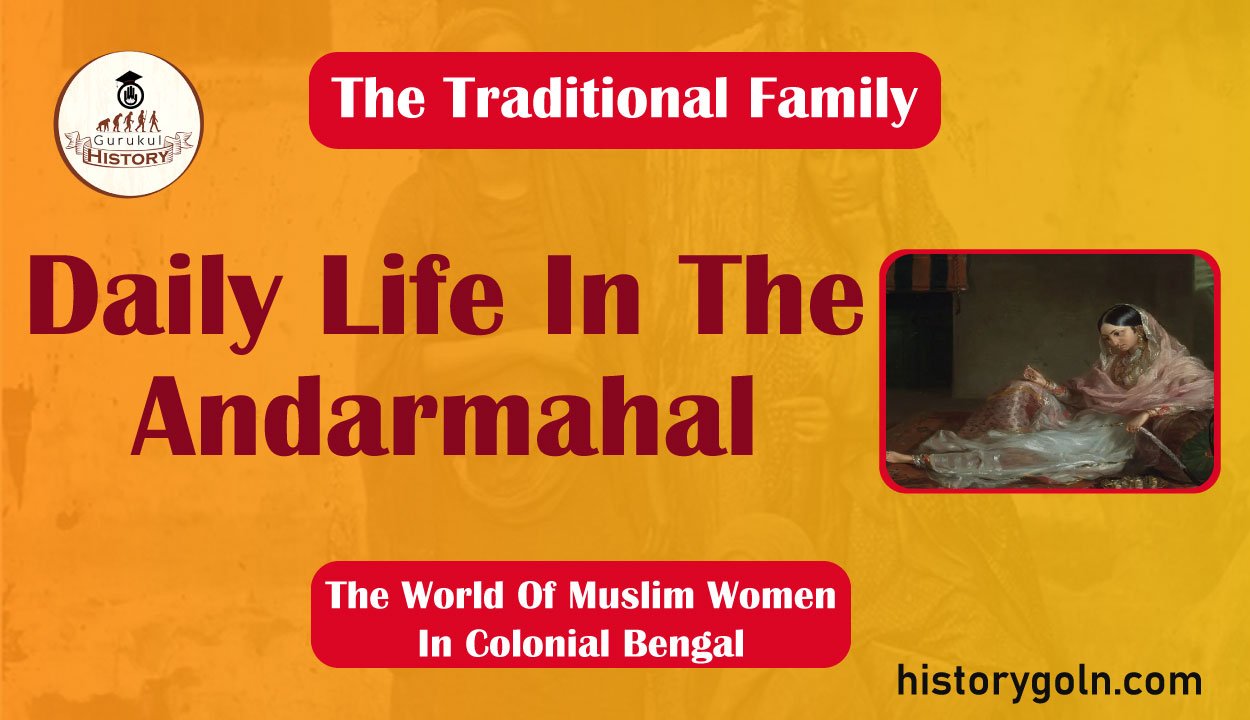Today our topic of discussion is Daily Life In The Andarmahal .
Daily Life In The Andarmahal

As in the Hindu household, the mistress of the house would supervise servants and other female members who had not achieved sovereign status, in cooking of meals, cleaning, serving, handing out rations, washing, etc.
In rich households there would be plenty of hours of relaxation which might be spent in story-telling, gossiping, sewing, reading religious texts or punthi, an occasional magician, snake charmer or performance.
Each stage of a woman’s life was marked by a ritual to relieve the boredom of andarmahal life earpiercing, completion of the Koran, a doll’s marriage, birthdays, weddings and religious festivals. Syeda Monowara recorded her memories of andarmahal life at the turn of the century:
Mother used to love listening to songs. Sometimes after the Zohr prayer she would summon all the maids to the verandah and bid them to sing… Mother would sometimes request particular songs… about weddings the bridal toilet, the coming of the groom, songs of farewell.
Sometimes Mother wanted to hear spiritual or marfati songs, or ancient ballads etc. Many of us would cry with emotion, at the beauty of the legends the pathos… such as that of Princess Komolmoni. Shaista painted a vivid picture of daily life in her grandfather’s residence in Calcutta around early 1920’s:
One sat and did one’s sewing and reading, ate pan and received visitors on the verandah… Nawab Syed Mohammad (her grandfather) perforce had to accept certain things for himself, but he was determined not to accept them for his womenfolk.
Both in Hindu/Brahmo and Muslim households vendors, barbers, masseuses, etc., from the outside formed the only link between the private and public spheres as well as between one family and another. 10 Shaista pointed to the link between the private and public spheres:
There were the women vendors, the choori-wali (bangle sellers), the Bisatin (women who sold ribbons, buttons, etc.)… But the selling of their wares was the least part of these women’s jobs. Their most important role was that of purveyor of news. They were, in reality, the newscarriers of the women’s world.

Experiences of the andarmahal were also recorded by Nawab Faizunnessa Chaudurani (1834-1903), Rokeya Sakhawat Hossein (1880-1932), Nurunnessa Khatun (1894-1975), and Syeda Monowara Khatun (1909-1981). Their experi- ences of the andarmahal, of course, predated Shaista’s. Nawab Faizunnessa made brief references to her childhood in the andarmahal in the preface to her book Rupjalal (1876).
She mentioned that during her childhood her future husband Mahmud Ghazi once caught a glimpse of her. One must assume that Mahmud was allowed entry beyond the strict boundary of purdah into the andarmahal only because he was one of her relatives.
Rokeya pointed to the andarmahal as being the woman’s sole domain in Aborodhbasini where she recounted episodes of women’s lives behind seclusion.
In Aborodhbasini (literally, women dwelling behind the Wall) based on real life instances one feels the full force of the separation of the andar from the outside world. In writing of her own childhood life in her father’s stately mansion in Payraband, Rangpur, Rokeya said:
From the age of five we girls had to observe purdah even from those of our own sex. Men were not allowed in the Antahpur so I did not have to suffer their oppression. Nurunnessa Khatun (1894-1975), the most prominent female writer of the period chosen here, was also born in an aristocratic family of Murshidabad.
In the presidential speech delivered at the Bengal Muslim Women’s Confer- ence in 1926 (1333 BS), Nurunnessa reminisced that inside the high walled apartments of the andar of her childhood home the only glory of nature that her eyes could feast on were the stars at night.

Syeda Monowara Khatun also referred to the andarmahal in her brief memoir Smritir Pata: “Purdah was very severe in the andar-mahal in our household. Even a male servant of 13 or 14 would not be allowed in”, Abul Fazl (1905-1983), up and coming writer in the 1920s in Dhaka, lamented the fact that literary creativity would always be hampered in a society which provided no scope for its men to know the true feelings of its women:
When I set out to write I realized how little we know our own society specially the domain of the family… So we would accost our mothers, aunts, sisters or cousins for glimpses of the unknown Muslim Antahpur.
See more:
